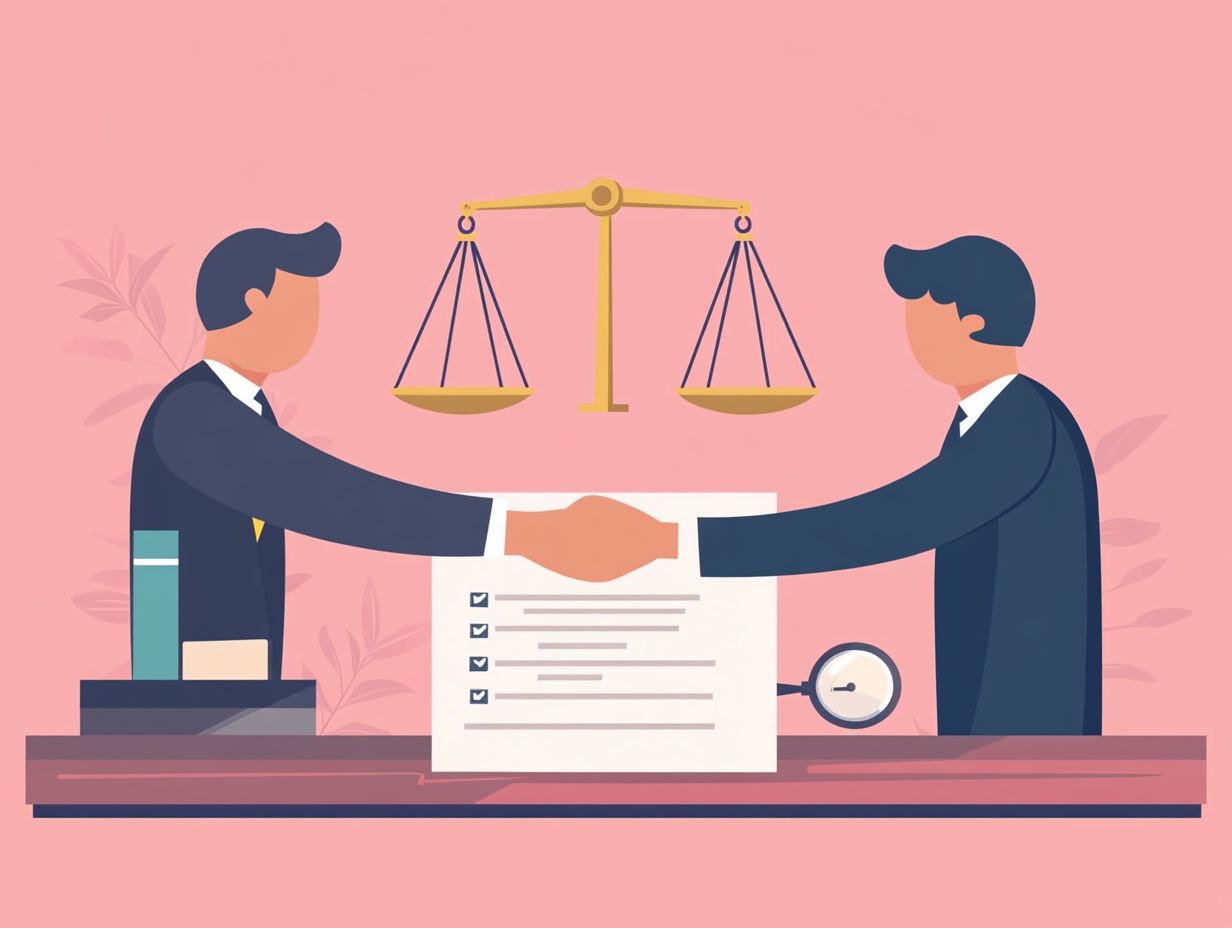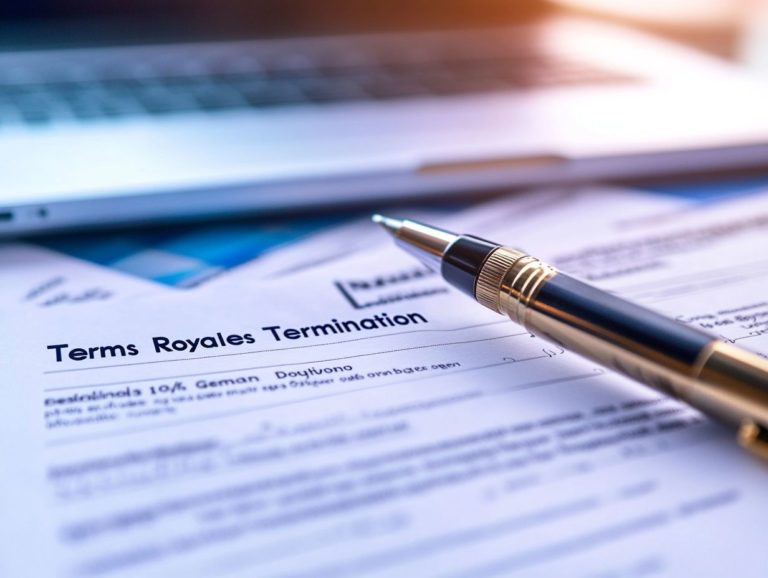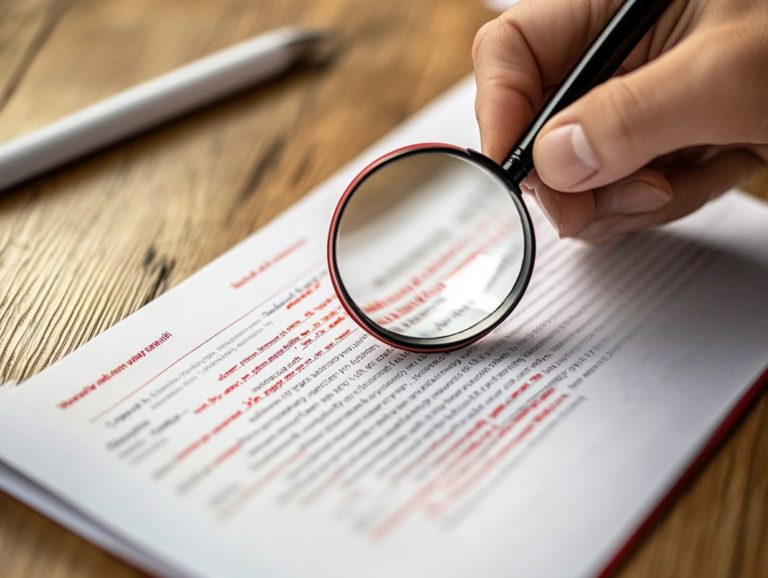How Licensing Agreements Affect Patent Rights
Licensing agreements are essential tools in intellectual property. They provide a clear way for you to share your innovations while keeping control over your creations.
This article explores the details of these agreements, including definitions, types, and their interaction with patent rights. It highlights the benefits they offer, like market expansion and revenue generation, along with key things to think about before you enter any agreement.
It also guides you on how to enforce these agreements effectively, ensuring your rights are protected at every step.
Contents
- Key Takeaways:
- Understanding Licensing Agreements
- Types of Licensing Agreements
- How Licensing Agreements Affect Patent Rights
- Benefits of Licensing Agreements
- Considerations Before Entering a Licensing Agreement
- Enforcing Licensing Agreements
- Frequently Asked Questions
- What are licensing agreements and how do they affect patent rights?
- How do licensing agreements impact the exclusivity of patent rights?
- Can licensing agreements affect the duration of patent rights?
- How do licensing agreements affect revenue from patent rights?
- What happens if a third party breaches a licensing agreement?
- Are there downsides to licensing agreements for patent holders?
Key Takeaways:

Licensing agreements can affect patent rights by defining ownership and control, as well as limitations on the use and distribution of patented technology. They can help patent owners expand their market reach and generate income through licensing fees. For a deeper understanding of this relationship, explore the interconnection of licensing agreements and IP rights. Before entering a licensing agreement, carefully consider the legal and financial implications and take steps to protect patent rights through enforcement measures.
Understanding Licensing Agreements
Licensing agreements are crucial for you, whether you’re granting or receiving rights. To gain insight into these important legal documents, including how they define the use of patents and other intellectual property, consider exploring understanding trademark licensing agreements.
A good licensing agreement outlines not just the license’s scope but also payment terms and conditions to meet industry standards.
Definition and Purpose
A licensing agreement is a legal contract where a licensor gives you, the licensee, specific rights to use, produce, or sell a patented technology or intellectual property under agreed terms.
These agreements help commercialize innovations, allowing you to use unique technologies without needing to develop them yourself. By clearly stating the rights granted like territorial limits and duration the licensor protects their intellectual property while you can generate revenue.
This arrangement is great for both sides. It encourages collaboration and opens doors to new markets, creating opportunities for you and the licensor. You can leverage existing patents, reducing risks in research and development, while the licensor enjoys royalties and keeps control over their creations.
Types of Licensing Agreements
Licensing agreements fall into two main categories: exclusive and non-exclusive licensing. Each type has different levels of rights and restrictions that shape the relationship between the licensor and licensee, especially in patent and technology transfer.
Understanding these differences helps you navigate intellectual property more effectively.
Exclusive vs. Non-Exclusive Licensing
Exclusive licensing gives you unique rights to use a patent, allowing you to operate without competition in a specific market. Non-exclusive licensing permits multiple licensees to use the same patent, each with its own implications for patent rights and revenue.
Knowing the difference is vital for shaping your business strategy, especially if you’re involved in innovation. An exclusive agreement often provides a competitive edge since you’re the only one who can use the patented technology. This exclusivity can lead to significant revenue potential without competition, but keep in mind that the licensor may limit overall earnings by not allowing others to license the patent.
On the flip side, non-exclusive licenses allow for broader technology distribution, maximizing income through several streams. However, having multiple licensees can dilute individual revenue and complicate patent rights, leading to negotiations influenced by market conditions and demand.
Ready to dive deeper into licensing agreements? Consider seeking professional advice to help navigate this complex landscape.
How Licensing Agreements Affect Patent Rights

Licensing agreements play a crucial role in shaping patent rights, as they impact market competition by establishing ownership and control over the patent.
Through these agreements, both the licensor (the party granting the license) and licensee (the party receiving the license) are granted distinct rights. They also have specific restrictions and obligations that define their relationship and govern the utilization of the patent, as outlined in the connection between licensing agreements and copyright.
Impact on Ownership and Control
Licensing agreements significantly impact ownership and control. They determine who holds the legal authority to utilize patented technology, influencing the strategic decisions of both parties involved, including the legal implications of licensing agreements.
These agreements outline the terms of use and set the boundaries within which innovations can be developed and marketed.
As a licensor, the ability to grant or restrict access to your patents can create substantial revenue streams while safeguarding your intellectual property rights. If you re the licensee, it’s crucial to understand these terms carefully. Your operational strategies will depend on how effectively you can leverage the patented technology for a competitive edge.
This interplay of rights creates a dynamic landscape where both sides navigate complex decisions, ultimately shaping the future of innovation.
Limitations on Use and Distribution
Limitations on use and distribution within licensing agreements are essential components. They delineate the boundaries within which you can operate.
These rules specify geographical limits, dictating how and where the patented technology can be employed and the timeframes during which your license remains valid. They also include conditions regarding sublicensing, which prevent you from transferring rights without explicit consent.
These measures safeguard intellectual property and create a balanced marketplace, harmonizing innovation with competition. By clearly outlining these restrictions, both you and the licensor can reduce disputes and foster a cooperative relationship, encouraging ongoing collaboration and development.
Benefits of Licensing Agreements
Licensing agreements can really boost your market reach. They enhance opportunities for both licensors and licensees.
These arrangements open doors to potential revenue streams through the strategic commercialization of technology and intellectual property.
Expanding Market Reach
Expanding your market reach is a key benefit of entering into licensing agreements. By leveraging the resources and expertise of your licensees, you can effectively penetrate new territories and demographics.
This collaborative approach reduces the risks associated with venturing into unfamiliar markets and encourages innovation and adaptability. For example, imagine partnering with a local manufacturer who understands regional preferences; this could lead to customized products that resonate with the local audience.
A prime illustration is Disney s licensing of its characters to various merchandise producers, significantly boosting sales and brand recognition globally. Such agreements create strategic advantages, allowing you and your partners to capitalize on each other’s strengths, ultimately driving growth and enhancing your competitive positioning in the marketplace.
Don t miss out on the huge advantages that licensing agreements can offer!
Generating Revenue

Licensing agreements can be a fantastic way to generate revenue. By establishing royalty rates, you can earn a steady income while letting others use your valuable patented technology.
These rates are shaped through negotiations that consider market demand, the uniqueness of your technology, and historical sales data. As a licensor, these agreements create predictable income and boost the overall value of your intellectual property.
If you re a licensee, securing a license can unlock long-term revenue potential. This allows you to bring innovative products to market without the high costs of research and development.
Both parties need to carefully consider financial implications and terms. This ensures mutual benefit and helps avoid disputes.
Considerations Before Entering a Licensing Agreement
Before entering a licensing agreement, consider the legal and financial implications. Clarifying obligations and compliance requirements is essential to avoid ambiguity.
Legal and Financial Implications
The legal and financial aspects of licensing agreements significantly impact both licensors and licensees. A thorough examination of obligations, compliance standards, and potential liabilities is essential.
Even minor oversights can lead to costly disputes. For instance, if a licensee doesn’t follow quality control measures, it could harm your brand’s reputation.
Licensees face financial risks if they don’t have adequate rights to use intellectual property. This could result in legal action.
Both parties should negotiate meticulously. Clear terms and aligned expectations are vital.
Using straightforward legal language and maintaining open communication can prevent misunderstandings and protect against unexpected liabilities.
Enforcing Licensing Agreements
Enforcing these agreements is crucial for protecting patent rights. Doing so minimizes disputes and fosters a harmonious relationship between the licensor and licensee.
Steps to Protect Patent Rights
Effective licensing agreements require several critical steps to protect your patent rights. Start by establishing clear terms and understanding licensing agreements in IP strategy to ensure compliance with legal and industry standards.
Assess your patent portfolio and identify key assets that need protection. Discuss the scope of rights and obligations with the other party clearly.
Include provisions for monitoring usage to prevent unauthorized applications of your patent. Regular audits and a solid dispute resolution process reduce the likelihood of conflicts.
Transparency and communication are essential. This enhances compliance and promotes a culture of innovation.
Frequently Asked Questions

What are licensing agreements and how do they affect patent rights?
Licensing agreements are contracts between a patent holder and a third party. They allow the third party to use, sell, or distribute the patented product or technology, directly impacting the ownership and rights of the patent holder. For more information, refer to understanding the implications of licensing agreements.
How do licensing agreements impact the exclusivity of patent rights?
Licensing agreements can grant exclusivity to the third party, giving them the sole right to use or sell the patented product. Alternatively, they can allow non-exclusive use, meaning the patent holder can also issue licenses to others. For a deeper insight, consider understanding the role of licensing agreements in innovation.
Can licensing agreements affect the duration of patent rights?
Yes, licensing agreements can limit the duration of the patent rights given to a third party. Understanding the role of licensing agreements in intellectual property can help clarify whether these agreements are short-term or long-lasting.
How do licensing agreements affect revenue from patent rights?
Licensing agreements usually involve a payment system. The third party pays the patent holder a percentage of the profits from using or selling the patented product.
What happens if a third party breaches a licensing agreement?
If a third party breaches a licensing agreement, the patent holder can take legal action. This may lead to loss of revenue and could harm the patent holder’s reputation, highlighting the impact of licensing agreements on brand protection.
Are there downsides to licensing agreements for patent holders?
Licensing agreements can generate extra revenue and broaden the market for a patented product. However, watch out! They come with risks, such as losing control over the product and potential conflicts with other agreements.






